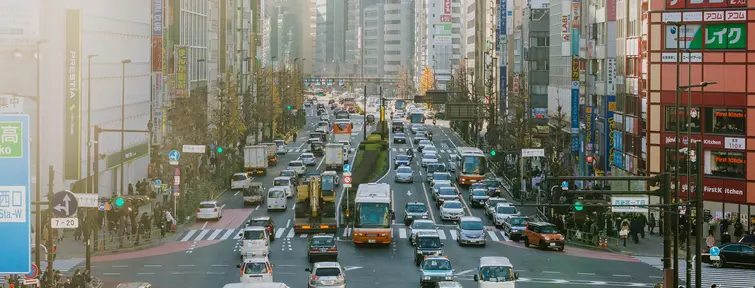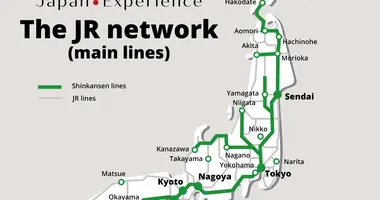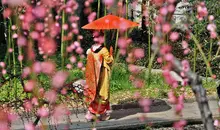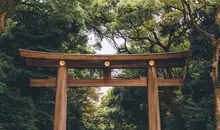Road signs and driving rules in Japan
- Published on : 04/05/2021
- by : OF
- Youtube
Taking to the Japanese roads is an exciting adventure that requires some specific knowledge of left-hand drive and local signage. Although driving in Japan may seem intimidating at first glance, it is in fact relatively accessible, thanks to well-maintained roads and abundant signage. Discovering Japan by car allows you to access less touristy areas and immerse yourself in the local culture. Before getting behind the wheel, however, it's essential to understand the peculiarities of the Japanese highway code and to prepare your administrative documents properly, especially the official translation of your driving license.
The specifics of left-hand drive and its general organization
In Japan, driving is carried out in the left-hand lane, with the steering wheel on the right-hand side of the vehicle. This practice dates back to feudal times, when samurai carried their swords on the left side of their bodies, making them easier to draw with the right hand. This tradition was reinforced during the modernization of the country during the Meiji era (1868-1912), when Japan turned to the UK to develop its industrial sector, particularly in the automotive field.
Adaptation to driving on the left is generally quite rapid. To ease the transition, it's advisable to start with short trips in lightly trafficked areas, and possibly to have a co-driver who can help you stay alert. Cars are often fitted with automatic gearboxes, making the adjustment much easier.
In big cities like Tokyo, some major roads have several lanes, depending on the direction you want to take. It's advisable to plan your route in advance to avoid changing lanes at the last minute, which is sometimes forbidden and often difficult in heavy traffic. The Japanese are generally disciplined drivers who scrupulously respect traffic rules.
Japanese road signs: features and interpretation
Signage in Japan is largely in line with international standards and is generally bilingual (Japanese and English), except in certain rural areas. Since 2017, a special effort has been made to gradually replace signs with bilingual versions, particularly in view of the Tokyo Olympic Games.
A few peculiarities of Japanese signage are worth highlighting:
- The stop sign is represented by an inverted red triangle inscribed with "止まれ" (tomare). It is imperative to come to a complete stop at the white line.
- Turn prohibitions are often indicated by blue arrows signaling the obligation to go straight ahead, rather than by arrows crossed out in red as in Europe.
- As in the USA, traffic lights are horizontal and located on the opposite side of the intersection. You have to stop at the white line before the crossroads, not at the foot of the light.
- Green arrows indicating authorized directions are frequently used.
- Signs indicating dangerous gradients are very precise, sometimes mentioning the exact percentage (e.g. 6.3%).
Freeways are marked on a green background, while expressways and trunk roads are marked on a blue background. This distinction is important for correct orientation.
Priority rules and behavior at intersections
At Japanese intersections, priority rules differ slightly from those in Europe. Here are the main points to remember:
At intersections, cars going straight ahead and those turning left have priority. Vehicles turning right must wait. If you're turning right, you should generally drive to the middle of the crossroads (a white stripe often indicates this position) and wait for other vehicles to pass before completing your maneuver.
Pedestrians have priority at crosswalks. At crossroads, you often have to let them cross before you can turn. This rule is strictly observed, and in the event of an accident involving a pedestrian, the driver will generally be held responsible.
Be particularly careful with cyclists, who can ride on sidewalks and cross at crosswalks. In many places, the distinction between lanes for cars and those for pedestrians is not clearly demarcated, requiring extra care.
Before crossing a level crossing, the driver must bring his vehicle to a complete stop, then check that no train is coming before crossing.
Speed limits and traffic controls in Japan
Speed limits in Japan are generally lower than in Europe, and vary according to road type:
- In urban areas: between 30 and 50 km/h
- In suburban areas and on other roads: 60 km/h
- On urban freeways: between 60 and 80 km/h
- On intercity highways: generally 100 km/h, with some sections at 120 km/h on the Shin-Tōmei and Tōhoku highways
Speed is closely monitored in Japan, with numerous fixed and mobile speed cameras. Roadside checks are frequent, and fines for speeding can be high, up to 100,000 yen (around €618). Nevertheless, it is common to observe Japanese drivers driving 10 or 20 km/h over the speed limit, particularly on freeways.
Japan has a zero-tolerance policy on drink-driving. The permitted blood alcohol level is 0%, and penalties are extremely severe: fines of up to one million yen and prison sentences of several years. Passengers who allow an alcoholic to drive may also be penalized.
The authorities are also strict on illegal parking, with fines of up to 18,000 yen (approx. €111).
The peculiarities and challenges of urban driving
Driving in Japanese urban areas presents a number of specific challenges. In large cities such as Tokyo or Osaka, traffic can be dense and streets can be narrow, with many lanes to take depending on the desired direction.
The roadway is often shared between different users. You'll need to keep an eye out for cars parked on the side of the road, which can impede traffic flow, bicycles coming out or going the wrong way, vans being unloaded, and delivery company employees crossing the road.
Parking in the city is generally chargeable and can be expensive. Parking spaces are often equipped with a vehicle blocking system: an articulated bar automatically rises from the ground to rest against the underbody of the car, preventing it from leaving before payment has been made. To retrieve your vehicle, you'll need to identify the number of your parking space, enter this number in the payment machine, then insert the required amount (credit cards are not always accepted).
Some cities have automated garages where your vehicle is stored in a tower by means of an elevator. This system optimizes space, but can be confusing for unaccustomed drivers.
In Japan, it is customary to park in reverse, which facilitates exit and improves visibility, thus reducing the risk of accident.
Driving in rural areas: infrastructure and precautions
Driving in rural Japan offers magnificent scenery, but has its own particularities. Roads can be narrower than in the city, sometimes barely wider than your vehicle. On some mountain roads, the width can be as little as 2 meters, making crossing with buses or trucks particularly tricky.
In rural areas, the roads are often lined with deep ruts for water drainage. You need to be careful not to fall into them, as this could damage your vehicle.
Signage in rural areas is sometimes only in Japanese, with no English translation. It may be useful to have a co-driver who can read Japanese, or to use an instant translation application.
Roadworks in rural areas can be confusing for foreign drivers. Construction signs are sometimes only in Japanese, and temporary traffic lights can be difficult to spot among other flashing signs.
For journeys in the mountains, we recommend renting a compact car (kei car), which makes driving easier on narrow, winding roads. These vehicles are around 30 cm narrower than standard cars, which makes all the difference on mountain roads.
Also note that GPS can be less reliable in rural areas, with poorly-labeled speed limits and sometimes incorrect information about shops or roads. Allow extra travel time and be prepared to adapt your route.
Japanese driver behavior and courtesy codes
Japanese drivers are generally courteous and respectful of traffic rules, which makes driving relatively safe. However, there are some specific behaviors worth mentioning to prepare you for them.
Turn signal use is sometimes late. Some drivers have a tendency to stop just about anywhere, putting their blinker on at the last minute. Be particularly careful with cabs and delivery vehicles, which frequently make unexpected U-turns and reverses.
In Japan, cars displaying special stickers indicate the type of driver:
- A yellow and orange leaf at the rear of the vehicle indicates that it is driven by an elderly person.
- Two green and yellow diamonds indicate a novice driver.
This information is invaluable in adapting your driving style and patience if necessary.
On freeways, an ETC (Electronic Toll Collection) system allows you to pass tolls without stopping. If you're renting a car, we recommend you take out the ETC card option, which only costs around 300 yen for the entire rental period. You will pass through the lanes indicated in blue by the ETC signs, and the charges will be automatically recorded and invoiced when you return the vehicle.
Rest areas on Japanese freeways are well-equipped, with a wide selection of quality restaurants at affordable prices, clean and functional toilets, and several souvenir stores. It's a pleasant change from the highway services you'd find in Europe.
Before driving in Japan, don't forget to translate your driver's license with the Japan Automobile Federation (JAF), as the international license is not recognized for French citizens. This formality is indispensable for renting a car and driving legally on Japanese roads.
In short, driving in Japan is an enriching experience that will enable you to discover aspects of the country inaccessible by public transport. With proper preparation and respect for local rules, you'll be able to make the most of this adventure on the roads of the Land of the Rising Sun.










